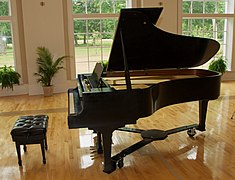|
Shizuoka Prefecture
Shizuoka Prefecture (静岡県, Shizuoka-ken) is a prefecture of Japan located in the Chūbu region of Honshu.[2] As of September 2023,[update] Shizuoka Prefecture has a population of 3,555,818 and has a geographic area of 7,777.42 km2 (3,002.88 sq mi). Shizuoka Prefecture borders Kanagawa Prefecture to the east, Yamanashi Prefecture to the northeast, Nagano Prefecture to the north, and Aichi Prefecture to the west. Shizuoka is the capital and Hamamatsu is the largest city in Shizuoka Prefecture, with other major cities including Fuji, Numazu, and Iwata.[3] Shizuoka Prefecture is located on Japan's Pacific Ocean coast and features Suruga Bay formed by the Izu Peninsula, and Lake Hamana which is considered to be one of Japan's largest lakes. Mount Fuji, the tallest volcano in Japan and cultural icon of the country, is partially located in Shizuoka Prefecture on the border with Yamanashi Prefecture. Shizuoka Prefecture has a significant motoring heritage as the founding location of Honda, Suzuki, and Yamaha, and is home to the Fuji International Speedway.  HistoryShizuoka Prefecture was established from the former Tōtōmi, Suruga and Izu provinces.[4] The area was the home of the first Tokugawa shōgun.[citation needed] Tokugawa Ieyasu held the region until he conquered the lands of the Hōjō clan in the Kantō region and placed land under the stewardship of Toyotomi Hideyoshi. After becoming shōgun, Tokugawa took the land back for his family and put the area around modern-day Shizuoka City under the direct supervision of the shogunate. With the creation of the Shizuoka han from the Sunpu Domain in 1868, it once again became the residence of the Tokugawa family. GeographyShizuoka Prefecture is an elongated region following the coast of the Pacific Ocean at the Suruga Bay. In the west, the prefecture extends deep into the Japan Alps. In the east, it becomes a narrower coast bounded in the north by Mount Fuji, until it comes to the Izu Peninsula, a popular resort area pointing south into the Pacific.[citation needed] As of April 2012,[update] 11% of the total land area of the prefecture was designated as natural parks, namely the Fuji-Hakone-Izu and Minami Alps National Parks; Tenryū-Okumikawa Quasi-National Park; and four Prefectural Natural Parks.[5] ClimateIn Shizuoka prefecture, the temperature, over the course of the year, typically varies from 34 °F to 87 °F and is rarely below 28 °F or above 93 °F. The summers in Shizuoka are warm, oppressive, and mostly cloudy; the winters are very cold, windy, and mostly clear.[6] DisasterOn 15 March 2011, Shizuoka Prefecture was hit with a magnitude 6.2 earthquake approximately 42 km (26 mi) NNE of Shizuoka City. It is said, that throughout history, Shizuoka area has experienced a large earthquake every 100 to 150 years. Demographics 3,635,220 people live in Shizuoka Prefecture, according to the 2020 census.[7] MunicipalitiesSince 2010, Shizuoka has consisted of 35 municipalities: 23 cities and 12 towns.
 Shizuoka (capital)静岡市 Hamamatsu浜松市 Atami熱海市 Fuji富士市 Fujieda藤枝市 Fujinomiya富士宮市 Fukuroi袋井市 Gotemba御殿場市 Itō伊東市 Iwata磐田市 Izu伊豆市 Izunokuni伊豆の国市 Kakegawa掛川市 Kikugawa菊川市 Kosai湖西市 Makinohara牧之原市 Mishima三島市 Numazu沼津市 Omaezaki御前崎市 Shimada島田市 Shimoda下田市 Susono裾野市 Yaizu焼津市 Higashiizu東伊豆町 Kawazu河津町 Minamiizu南伊豆町 Matsuzaki松崎町 Nishiizu西伊豆町 Kannami函南町 Kawanehon川根本町 Yoshida吉田町 Mori森町 Nagaizumi長泉町 Oyama小山町 Shimizu清水町 Municipalities in Shizuoka Prefecture Government Ordinance Designated City City Town MergersAfter the introduction of modern municipalities in 1889, Shizuoka consisted of 337 municipalities: 1 (by definition: district-independent) city and 23 districts with 31 towns and 305 villages. The Great Shōwa mergers of the 1950s reduced the total from 281 to 97 between 1953 and 1960, including 18 cities by then. The Great Heisei mergers of the 2000s combined the 74 remaining municipalities in the year 2000 into the current 35 by 2010. List of governors of Shizuoka (since 1947)
IndustryHome to a shogun, cherry shrimp, and Japan's green tea heartland. Situated along Suruga Bay between Tokyo and Nagoya on the historic Tokaido route, the Pacific coast city of Shizuoka is famed for supplying most of Japan's tea and maguro tuna. MotorcyclesShizuoka-based companies are world leaders in several major industrial sectors. Honda, Yamaha, and Suzuki all have their roots in Shizuoka prefecture and are still manufacturing here. Thanks to this, Shizuoka pref. accounts for 28% of Japanese motorcycle exports.[8] Musical instrumentsYamaha and Kawai are both global piano brands. Yamaha has the largest share in the global piano market. Kawai has the second largest share. They both got their start in Shizuoka pref. in the early twentieth century.[8][9] Yamaha and Roland are major brand for electronic musical instruments. In the electronic piano world market, Yamaha has the world's largest share. Roland and Kawai have the second and third place share. Roland and Yamaha also manufacture high-quality synthesizers and drum machines for professional musicians. In addition, various instruments such as wind instruments and guitars are manufactured in this prefecture. There are about 200 companies that manufacture musical instruments, in this prefecture. Most of these musical instruments are especially produced in Hamamatsu City.[9]
TransportationRail    
RoadsExpressways
Toll roads
National highways
Airports Ports
EducationUniversitiesNational universities
Public universities Private universities
Senior high schools
Sports The sports teams listed below are based in Shizuoka. BasketballMotorsportRugbyFootball
VolleyballTourismMuseumsTheme parks
Festivals and events
Notable peopleMotoo Kimura (木村 資生, 1924–1994), biologist and theoretical population geneticist, died in Shizuoka Prefecture Notes
References
External linksWikimedia Commons has media related to Shizuoka prefecture. |
|||||||||||||||||||||||||||||||||||||||||||||||||||||||||||||||||||||||||||||||||||||||||||||||||||||||||||||||||||||||






































